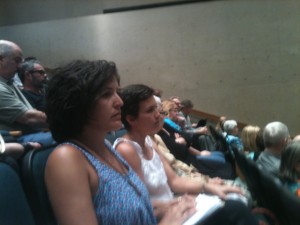Ozone
Wake-Up and Breathe the Air Quality Progress/ Update X2
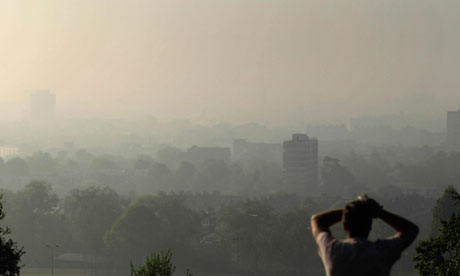 6:00 pm Update: Rockwell hasn't hit 125 ppb yet, but it's hovered in the "red" high teens for three hours according to the latest update from TCEQ, which only goes up to 4 pm. Frisco, Arlington Airport and the old Redbird Airport monitors still seem likely to have their fourth and so, official violation the 1997 ozone standard of no more than 85 ppb for an eight hour stretch.
6:00 pm Update: Rockwell hasn't hit 125 ppb yet, but it's hovered in the "red" high teens for three hours according to the latest update from TCEQ, which only goes up to 4 pm. Frisco, Arlington Airport and the old Redbird Airport monitors still seem likely to have their fourth and so, official violation the 1997 ozone standard of no more than 85 ppb for an eight hour stretch.
3:30 pm Update: In the time it took to write this, Rockwall has seen its ozone levels rise to 119 parts per billion. The very old original ozone standard was 125 ppb over a one-hour period. That's considered not just a red alert day – that's getting deep purple. We already had one of those in Arlington in June. Rockwall is on its way.
Original Post:
DFW's luck with the wind has ended.
Breezes have slowed and pivoted to the East, carrying coal plant and natural gas mining pollution. At 11 am the Rockwall smog monitor was already at 91 parts per billion; the next hour it was 111 ppb. The new federal standard is 75 ppb. Now a broad front of five monitors are in the 90's, from Frisco to Arlington. Of those five, two are just one more "exceedance" of the old 1997 standard of 85 ppb – a standard that despite two clean air plans from Austin, DFW has never managed to meet. if they trip today, that would bring the total number of DFW monitors officially out of compliance with that '97 standard to five.
As late as last December, the Texas Commission on Environmental Quality was maintaining with a straight face that there would be NO MONITORS OUT OF COMPLIANCE WITH THE 1997 OZONE STANDARD. Whenever you'd point out that we just had the worst year for ozone since 2007, or that such a goal would require the lowest ozone levels ever recorded in DFW, TCEQ staff would shrug their shoulders and say, "That's what the computer model tells us," as if that was that. In their own way, TCEQ has become the technocratic equivalent of those who beleive in the inerrent word of the Bible. The Bible Says It, I Believe It, and That Settles It. Substitute the word "model" for "bible," and you have the philosophy driving the TCEQ response to DFW's chronic dirty air. 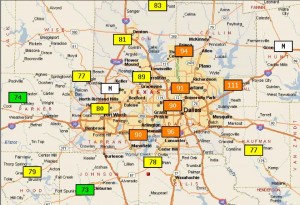
Of course, it matters what variables you put in that model, and how much weight you assign them, and how you run it. And if you're an extension of Rick Perry's permanent campaign machinery. In that case, the model has to say things will get better – because otherwise your critics would say the state needs EPA help to clean up the air; needs to not recommend new pollution control measures – because otherwise it would contradict your anti-government crusade; and needs to ignore the most potent source of new emissions in the last 20-30 years from what is historically the most powerful industry in Texas.
If you have all that going for you, well then why sure, every summer is a new chance to once again prove how the invisible hand of the marketplace can take care of everything. And if it doesn't? Well, it was the EPA's fault for interfering with the marketplace. You can never lose.
The biggest purveyor of junk science in Texas is TCEQ. It's become exactly what it criticizes. Local DFW governments say they are dependent on the agency to provide them with "expertise" they just can't afford. But what's the value of that expertise when: 1) It's always wrong, and, 2) TCEQ is acting directly against local interests by letting ideology trump good science?
In 2010, just one or two monitors were violating the 1997 standard. Last year it was seven. By the end of the day today it could be five. The smog is getting thicker, and TCEQ is playing with its inerrant models.
3rd DFW Ozone Monitor Officially Trips the 1997 Standard
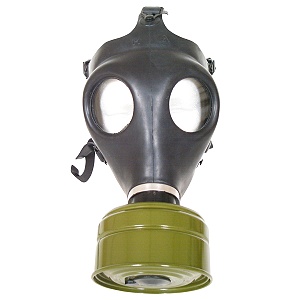 What were we saying about smog problems marching east with the gas drilling?
What were we saying about smog problems marching east with the gas drilling?
Yesterday's dirty air left the Dallas North site – south, and downwind of LBJ's mess – with its fourth exceedance of the 1997 85 parts per billion (ppb) ozone standard. That means it's an official violation of that standard since every monitor gets three strikes before being called out. It joins the Grapevine and Dallas Hinton Street monitors in violating a 15-year old standard that has been declared unprotective of human health and replaced with a tougher standard of 75 ppb. 16 of 20 DFW ozone monitors have already violated that new standard this year, but those don't start counting against us until around 2015-16 when it takes full effect. At the same time, violations of the '97 standard it replaced don't count either. So DFW remains in a kind of smoggy purgatory. This wil be the 21st year we won't be in compliance with the federal clean air smog standard.
Last Wednesday, fracking proponents on the Dallas City Council kept refering to the Texas Commission on Environmental Quality as if it was some kind of immutable final word on all things environmental. Alas, the TCEQ is not infallible. With DFW air quality, it's never even been right. TCEQ's 2012 clean air plan for DFW was supposed to give us historically clean air with NO VIOLATIONS of the 1997 ozone standard. Now we've had three with another two months of ozone season left.
For the record, in 2010 we had one monitor with four violations of the '97 standard. That was as close as we've come to complying with it. Last year we had seven. This year we have three and still counting. Despite all of these violations contradicting the state's predictions, TCEQ still insists in calling this air quality progress. It's not. It's continued non-compliance with an old standard that most of the rest of the country already meets.
Thank you, It WAS a Watershed Moment in the Dallas Drilling Fight
 Yesterday's Dallas City Council briefing on a new gas drilling ordinance was supposed to be a showdown between dueling spokespeople for pro and anti-fracking arguments. And it did provide lots of memorable exchanges and statements. But the most dramatic moment of the day came courtesy of the audience itself.
Yesterday's Dallas City Council briefing on a new gas drilling ordinance was supposed to be a showdown between dueling spokespeople for pro and anti-fracking arguments. And it did provide lots of memorable exchanges and statements. But the most dramatic moment of the day came courtesy of the audience itself.
Dallas municipal law attorney Terry Welch was coming to the end of his presentation on why the recommendations from the city's task force should be strengthened: If we're wrong and fracking turns out to be completely safe, then you can always come back and liberalize strict regulations. But you can't undo the damage once drilling takes place with insufficient safeguards. Err on the side of public health and safety.
And with that, 90% of the packed room erupted into at least 60-90 seconds of continued and loud applause. But that wasn't the moment.
Because he had ended early, even after this round of applause, Welch had time left. Mayor Rawlings noted that and said something to the effect that "If you want to keep applauding for 4 more minutes I won't objec…." The last words of that sentence had not even left his mouth before the crowd took him up on his offer, began clapping wildly again and within seconds jumped to its feet with a sustained standing ovation that went on for the longest time. It was one continuous loud and kinetic vote in favor of doing more that was aimed directly at the Mayor and Council. That was the moment.
This was no public hearing, but the public most certainly was heard. It was the first time the Council had seen the depth and breath of support for stronger drilling rules. The pent-up energy from that applause was like a Blue Norther hitting the Council horseshoe straight-on.
Likewise, it was the first time the Council's constituents had seen the depth and breath of the pro-drilling members' belligerence and hopelessly out-of-date attitudes. It produced a lot of head-shaking.
We hope to bring you selected video from the meeting over the next couple of days. Meanwhile, here's a pretty good summary from the live blogging the Morning News was posting (do tell!), as well as a more sedate article for the paper itself.
Some highlights:
– You Care. There were so many of you – in August during work hours – that they had to move the meeting from the smaller briefing room to the Council Chambers, which were quickly filled too. It was a tremendous turnout. Thank you.
– Industry isn't satisfied. It's clear now that industry is trying to rollback the required distances between homes and wells even further than what the city's Task Force recommended after their last-minute collapse in February. A variance of 750 feet is no longer adequate. Now they want 600 feet. That's 400 feet closer than a strip club is allowed to get to a home in the City of Dallas.
– The council most ardent proponents of drilling share Ireland's view that the on-going national debate has been settled in their minds, and there are no serious hazards to fracking in urban areas.
– Mayor Rawling is very much engaged in this process and issue. He was attentive, asked good questions, and kept the lengthy proceedings flowing smoothly but democratically. Whatever else you may think of him or his motives, he's focused and direct on this subject.
– Citizen advocates Scott Griggs, Sandy Greyson, Angela Hunt and Carolyn Davis all asked great questions and provided a counterbalance to the Troglodyte contingent of the Council. You might want to drop them a thank you note.
– "Sulfuric Sheffie" Kadane – In what was the most jaw-dropping exchange of the day, Councilmember Kadane asked Welch if he knew what kind of chemicals would be spilled at a fracking site. Not waiting for an answer, he offered not benzene, or toluene, or diesel fuel, but Sulfuric Acid. Perfectly harmless stuff! We use it to clean our swimming pools! A little Sulfuric Acid wasn't going to hurt anyone.
– Jerry "El Conejo "Allen – Councilman Allen was obsessed with all the "rabbit holes" Welch and other could go down in terms of the hazards of fracking and thought he had all the ammunition he needed from spending a couple of hours going down some of them via Google. These rabbit holes are known to the rest of us as research. Did Welch know that the Trinity River was full of treated sewage right now?! Did he know how many regulatory agencies oversaw fracking? Did he know that thousands of people die every year from exposure to chemicals in the home? Wasn't fracking only dangerous because people were talking about it? Above all else, he kept reminding everyone that the gas operators had already paid the city 34.8 million for lease rights and not only do they deserve something in return but that's a lot of money!
Angela "Law and Order" Hunt – The most revealing exchange all day was Hunt's cross examination of hostile witness Ed Ireland, the gas PR hack Kadane had chosen to give the industry arguments, over full disclosure of all chemicals being used in fracking. She asked Ireland if he had any problem with Dallas writing an ordinance that would demand the listing of every single chemical being used on site. Not at all, Ireland said. Of course, he added, the operators themselves don't always have the last say. They hire contractors like Haliburton to come in and actually do the fracking and THEY might have a problem disclosing their fracking fluid recipes. Three times Hunt posed the same question, never letting Ireland escape a conclusive, definitive answer. Do you support full disclosure? And Ireland gave three slippery answers that finally pulled the curtain away from the industry's premeditated deception.
We're gaining momentum. By the end of he day, there was such a stark contrast between the advocates and arguments for more protections versus the Hollywood-scripted arguments of the other side, that you could almost hear the collective council pivoting to our side, despite no vote being taken. We can't afford to be over confident, but if we keep the pressure on, we can win this fight.
Next stop – We need at least one, if not two evening public hearings on the ordinance. As you contact your city council reps, please be sure to include this request.
Smog Update: On the Brink
 Strong winds are usually among the most efficient smog-stoppers DFW has. Despite this last week's record-setting heat wave, ozone levels didn't go crazy like they did in June because the winds kept blowing. Only the Rockwall monitor recorded an "exceedance" of the 1997 85 parts per billion ozone standard on Saturday, it's first of the season.
Strong winds are usually among the most efficient smog-stoppers DFW has. Despite this last week's record-setting heat wave, ozone levels didn't go crazy like they did in June because the winds kept blowing. Only the Rockwall monitor recorded an "exceedance" of the 1997 85 parts per billion ozone standard on Saturday, it's first of the season.
That makes 17 out of 20 DFW monitors that have at least one such exceedance of the 85 ppb standard. 11 of 20 have at least two. 7 out of 20 have at least three. And 2 out of 20 already have the four exceedances they need to be registered as a violation of the standard (a "non-attainment area" ozone monitor gets three strikes before the fourth-highest reading gets counted against it).
That means we're just one bad air day away from seeing five more monitors record their fourth exceedance and become violators. Two bad days away from having nine – and August is traditionally much worse for ozone than July.
In 2010, there were two monitors in violation of the 85 ppb standard. Last year there were seven. Industry and state government have been trying to tell the public DFW is still making air quality progress despite these numbers – that last year was just an anomaly because of the drought. Not sure how they'll spin another year of seven or more monitors out of whack with a 15-year old smog standard
Let's remind everyone again that according to Governor Perry's three TCEQ Commissioners, there were going to be no violations of the 85 ppb standard this year, that this is the second state plan in a row to fail to meet the 85 ppb standard, and that the new EPA smog standard is 75 ppb. Heck of a job TCEQ.
Rejected Smog Standard Would Have Saved 4100 Lives Annually – including DFW Residents
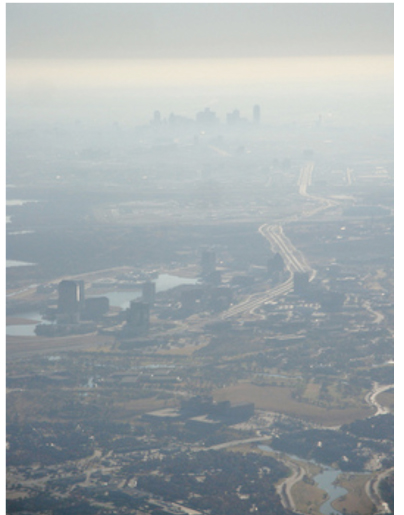 The EPA-proposed ozone/smog standard of 70 parts per billion the White House rejected at the last minute in 2011 would have saved almost twice as many lives per year over and above the Bush-era standard of 75 ppb that was eventually adopted, according to a new study by John Hopkins University scientists.
The EPA-proposed ozone/smog standard of 70 parts per billion the White House rejected at the last minute in 2011 would have saved almost twice as many lives per year over and above the Bush-era standard of 75 ppb that was eventually adopted, according to a new study by John Hopkins University scientists.
Most of those new leases on life would have come in large cities like New York, Chicago, and Los Angeles, where smog levels are historically high. But researcher say the standard would also have saved a significant number of DFW lives as well.
The lower standard was rejected by the Office of Management and Budget, and Executive Branch agency that has grown to have veto power over almost all EPA regulatory decisions based on their economic impact – a variable specifically excluded from consideration in the Clean Air Act.
The John Hopkins team also concluded that the lower 60 ppb standard that was in the lower range of what was recommended by EPA's own science advisory would have saved up to 8000 lives per year, compared with the 2500 annual lives estimated to be saved under the more lenient 75 ppb standard.
In addition to more lives saved, the study concluded that millions of asthma attacks and acute respiratory problems would be prevented with a lower ozone standard.
“We contend that a more stringent standard would prevent a substantial number of adverse health outcomes,” wrote the researchers, led by senior scientist Frank Curriero of the Johns Hopkins Bloomberg School of Public Health.
They calculated the reduced deaths by incorporating data from a variety of health studies around the country that have found that whenever ozone levels rise, deaths and hospitalizations from cardiovascular and respiratory problems rise, too.
There was also a warning that climate change would make higher ozone levels more likely, as seems to be in play this year with much of the country experiencing the kind of drought and heat Texas had last summer, and with national ozone level spiking.
EPA officials estimated that achieving the rejected 70 ppb standard would cost between $19 billion and $25 billion per year, including the estimated $8 billion for meeting the current standard set by the Bush administration in 2008. However, the agency estimated the health benefits would be worth $11 billion to $37 billion per year. Based on new evidence of medical costs associated with ozone pollution, that figure may have been very conservative.
The EPA's next review of the standard is supposed to begin in 2013. The Clean Air Act requires an evaluation every five years; Jackson, however, had planned to act early until Obama asked her to stop.
Meanwhile, DFW still can't meet the old 1997 85 ppb standard after three clean air plans in the last seven years. This year's fate is already sealed thanks to the June smog attack we had early on. Our worst monitors are averaging above 85 ppb and we haven't gotten to August – traditionally our worst month. Smog is taking its toll on our health in DFW, even if it doesn't make the nightly news.
New Study: Reducing Smog Brings More Health Benefits
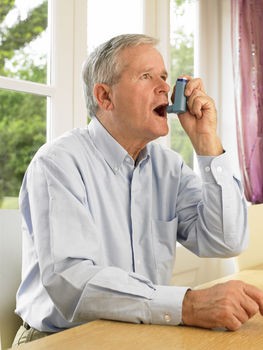 In the same Washington Post article on the monkey business surrounding the new PM pollution standard comes news of a new study that concludes cutting smog pollution could bring added health care benefits that haven't been accurately estimated in the past.
In the same Washington Post article on the monkey business surrounding the new PM pollution standard comes news of a new study that concludes cutting smog pollution could bring added health care benefits that haven't been accurately estimated in the past.
Researchers at the University of California at Santa Barbara and MIT examined data for five years between 2003 and 2008 from the 20 Eastern states and the District of Columbia where power plants and boilers are required to limit nitrogen oxide pollution between May 1 and Sept. 30 each year – in other words, "oozne season."
During this time, they found prescription drug expenditures dropped by 1.9 percent, or $900 million a year, and the states and DC had 2,200 fewer annual premature deaths among individuals aged 75 or older.
“This is now new evidence of the evidence of the health benefits of ozone reductions, which was not available when the president overturned the previous effort to revise the ozone standard,” said MIT economist Michael Greenstone, who has informed White House officials of his findings.
As Gas Mining Moves East, So Do Smog Violations
Failing the Test on Smog
 This is a response to statements in this.
This is a response to statements in this.
1) "The downward trend" that Mr Clawson of TCEQ says has only been "interrupted," is, in fact continuing, and he knows this because it's TCEQ monitoring that's proving it. This last March saw the highest ozone levels ever recorded for that month since TCEQ air quality monitoring began in 1997. It's only June, and there are already two monitors whose three-year runing average "Design Value" is above the old 85 ppb standard. The "best ever" ozone summer we were supposed to experience this year, according to TCEQ's prediction to EPA submitted in December, is completely off the rails.
2) The "87 ppb" Design Value Mr. Clawson cites is from 2010. Last year it was 92 ppb – at the Keller monitor. This year so far, the Keller monitor is already at a Design Value of 87, a violation of the old standard and something TCEQ said would not happen.
3) The NCTCOG claim that,"the DFW region has a tougher time than other metropolitan areas in the U.S. because of its climate plus its position downwind from outside sources of pollution" is also misleading. Houston is a hotspot for bad air, and yet last year DFW exceeded the number of bad air days and the severity of the violations in that city. Other metropolitan ares downwind of power plants as well as DFW, and yet they've all managed to do better in achieving cleaner air. Atlanta, Phoenix, and other Sunbelt cities that started out at the same smoggy spot a decade ago have all conquered the old 85 ppb std. DFW has not. It's already blown it again this year. Instead of blaming climate or coal plants, it is more realistic to blame DFW's air quality failure on a lack of political will by local and state officials to get serious about decreasing air pollution.
However, there is one large area of policy where the excuses of lack of will and new downwind sources collide – in the official lack of attention paid to the rise of Barnett and Haynesville Shale gas pollution as a source of smog in DFW.
4) The statement that only "5 percent" of the smog-forming emissions in DFW come from oil and gas drilling and production is also highly misleading. First, we know this is one of the fastest-growing categories of air pollution over the last decade. The increase in gas pollution is erasing decreases in emissions from other sources. Second, according to the information submitted by TCEQ to EPA last December, oil and gas emissions are the second largest source (20%) of smog-forming Volatile Organic Compounds, or VOCs in the 9-county DFW non-attainment area. That's more than the total VOCs produced by all on-road vehicles in the same 9 county area. Based on recent field studies by NOAA and others, this is probably an underestimate.
This statement also ignores the impact of gas emissions to the south and east of DFW, like Freestone County's, that are not included in the 9-county area inventory, but are probably influencing air pollution here.
What's always left out of this pie chart is the fact that cars now have a removal efficiency of approximately 90%. No other major sources come close to that kind of effort, despite technology being available to achieve it – at cement kilns, gas operations. and coal plants. That's where "the lowest hanging fruit" remains. But since all those industries are large contributors to the politicians directing the status quo, there's no political will to target them. Exhibit A: the 2011 DFW clean air plan submitted by the state, which relies primarily on marketplace forces to replace old cars with new ones, instead of any new round of pollution controls for any industry sources.
5) The NCTCOG claim that "monitors in the north Dallas and Frisco areas have had the highest readings of the region but the plume seems to be shifting west" is also based on old data. In fact, the opposite is occurring. Violating monitors are moving EAST (just like gas mining). And there are more of them. From 2008 to 2010, Eagle Mountain Lake and Keller were the epicenter of smog in DFW. But in 2011, while Keller tripped the std, EML did not. Moreover, during that same 08-10 period there were only 1-3 monitors in violation of that std. Last year, there were seven. And they included not just Keller and Parker County, but Denton, Grapevine, Pilot Point, Frisco and North Dallas – directly in contradiction to the NCTCOG claim.
This year, the very first monitor to record four "exceedances" of the 85ppb std was located near Mockingbird and I-35 in Central Dallas – the first time that monitor has done so since 2005. Moreover, the fourth exceedance came in June – the earliest that has happened since 2006, when 12 out of 19 monitors were in violation at the end of the summer.
As much as the officials and agencies would like us all to ignore the summer of 2011 and think of it as an aberation, it would be more prudent to see it as another warning sign that DFW needs to do much more to get safe and legal air.
June Smog Attack: Day 3
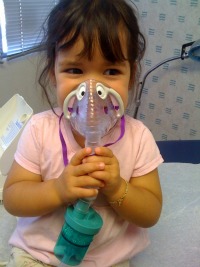 High ozone levels continued to take their toll on people and monitors Wednesday. Grapevine joined the Hinton Street Dallas monitor in recording its fourth "exccedence" of the old 1997 85 ppb smog standard and so establishing an official violaiton of it.
High ozone levels continued to take their toll on people and monitors Wednesday. Grapevine joined the Hinton Street Dallas monitor in recording its fourth "exccedence" of the old 1997 85 ppb smog standard and so establishing an official violaiton of it.
This is an 8-hour standard wherein the average over eight hourly readings must be 85 or above, So we're not talking about short-term spikes. These are day-long spikes.
Monitors in Keller, Eagle Mountain Lake, Arlington, North Dallas and the Redbird area of southwest Dallas saw their third exccedence of the 85 ppb standard, meaning one more day of bad smog could also make them environmental crime scenes. Midlothian, Northwest Ft. Worth, and Frisco all have two exceedences as of yesterday,
We're going to wait until there's a pause in the bad news to look at how off the mark the all powerful and holy TCEQ computer model is so far, but suffice to say that after this week, there's not likely to be any monitor inside the nine-county area that will even be close.
Happy Ozone Non-Attainment Day!
 Ozone Non-Attainment Day is a traditional annual DFW event. Every summer there's a day when one or more air quality monitors records its fourth "exceedence" of whatever national ozone standard the region is violating. Then and only then does the monitor officially violate the Clean Air Act and put DFW in "Non-Attainment" of clean air once again.
Ozone Non-Attainment Day is a traditional annual DFW event. Every summer there's a day when one or more air quality monitors records its fourth "exceedence" of whatever national ozone standard the region is violating. Then and only then does the monitor officially violate the Clean Air Act and put DFW in "Non-Attainment" of clean air once again.
Gifts of inhalers, oxygen tanks, and emergency room visits are often exchanged by family members and friends on and around the actual day of Non-Attainment.
This year Governor Perry and the Texas Commission on Environmental Quality made sure our Ozone Non-Attainment Day arrived extra early. Usually, we don't see it come until August. In fact, ever since ozone monitoring began in 1997, there's only been one other year when it came as early as this year.
In 2006, we had Non-Attainment day on June 14th. Boy, that was a doozy of a summer – 12 out of 19 monitors eventually tripping. Think this one might be as big? It's sure possible.
One sign is that the monitor that triggered this year's Non-Attainment Day is the historic Hinton Street site near Mockingbird and I-35. This particular monitor hasn't even recorded a violation of the Clean Air Act since 2005 – so welcome back Hinton Street! But this site has a long and storied Non-Attainment history. The Hinton Street monitor recorded violations for five years straight during some of the worst smog pollution DFW has ever seen, from 2000 to 2005, with some of those years seeing 14 out of 18 monitoring sites recording violations.
So Hinton Street monitor violations are associated with really bad air. So are Non-Attainment Days that arrive in June. We could have one long hellacious summer ozone pollution episode ahead of us this year. Maybe even a return to double-digit monitors in violation. Isn't it exciting?
You may want to send Non-Attainment Day greetings to Governor Perry and TCEQ Chair Bryan Shaw, since it was their idea of watching people buy newer cars as a pollution control strategy, along with ignoring the large increase in smog-forming pollution from the natural gas industry, that made this June Non-Attainment Day possible. (Downwinders reminds you to please breathe responsibly).

